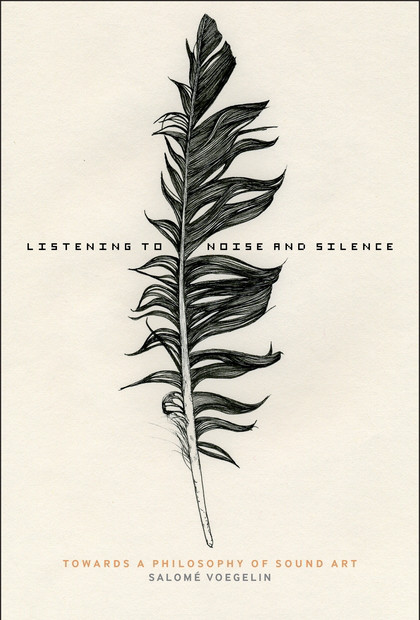Salomé Voegelin: Listening to Noise and Silence: Towards a Philosophy of Sound Art (2010)
Filed under book | Tags: · aesthetics, noise, philosophy, silence, sound art, sound recording

“Listening to Noise and Silence engages with the emerging practice of sound art and the concurrent development of a discourse and theory of sound. In this original and challenging work, Salomé Voegelin immerses the reader in concepts of listening to sound artwork and the everyday acoustic environment, establishing an aesthetics and philosophy of sound and promoting the notion of a sonic sensibility.
A multitude of sound works are discussed, by lesser known contemporary artists and composers (for example Curgenven, Gasson and Federer), historical figures in the field (Artaud, Feldman and Cage), and that of contemporary canonic artists such as Janet Cardiff, Bill Fontana, Bernard Parmegiani, and Merzbow.
Informed by the ideas of Adorno, Merleau-Ponty and others, the book aims to come to a critique of sound art from its soundings rather than in relation to abstracted themes and pre-existing categories. Listening to Noise and Silence broadens the discussion surrounding sound art and opens up the field for others to follow.”
Publisher Continuum, London and New York, 2010
Music/Sound Studies series
ISBN 1441162070, 9781441162076
256 pages
Reviews: Daniela Cascella (Journal of Sonic Studies), Brian Kane (NonSite).
PDF (updated on 2018-4-30)
Comment (1)Roman Jakobson: Six Lectures on Sound and Meaning (1976/1978)
Filed under book | Tags: · art, language, linguistics, meaning, semiotics, sound recording

As Lévi-Strauss writes: “These innovatory ideas, towards which I was no doubt drawn by my own thought but as yet with neither the boldness nor the conceptual tools necessary to organize them properly, were all the more convincing in that Jakobson’s exposition of them was performed with that incomparable art which made him the most dazzling teacher and lecturer that I had ever been lucky enough to hear.”
This book is marked by Jakobson’s elegance and demonstrative powers. Jakobson never pursues abstract and sometimes difficult course of his argument without illuminating it by examples from a great variety of languages and from the arts.
Originally published as Six leçons sur le son et le sens by Les Editions de Minuit, Paris, 1976.
Translated by John Mepham
Preface by Claude-Lévi Strauss
Publisher The MIT Press, 1978
ISBN 0262100193
116 pages
Christopher Alex McLean: Artist-Programmers and Programming Languages for the Arts (2011)
Filed under thesis | Tags: · art, code, computing, language, live coding, programming, software, software art, sound recording, synaesthesia, visual programming
“We consider the artist-programmer, who creates work through its description as source code. The artist-programmer grandstands computer language, giving unique vantage over human-computer interaction in a creative context. We focus on the human in this relationship, noting that humans use an amalgam of language and gesture to express themselves. Accordingly we expose the deep relationship between computer languages and continuous expression, examining how these realms may support one another, and how the artist-programmer may fully engage with both.
Our argument takes us up through layers of representation, starting with symbols, then words, language and notation, to consider the role that these representations may play in human creativity. We form a cross-disciplinary perspective from psychology, computer science, linguistics, human-computer interaction, computational creativity, music technology and the arts.
We develop and demonstrate the potential of this view to inform arts practice, through the practical introduction of software prototypes, artworks, programming languages and improvised performances. In particular, we introduce works which demonstrate the role of perception in symbolic semantics, embed the representation of time in programming language, include visuospatial arrangement in syntax, and embed the activity of programming in the improvisation and experience of art.”
Doctoral thesis
Goldsmiths, University of London, October 2011
Supervisor Geraint Wiggins
Co-supervisor Mark d’Inverno
172 pages

